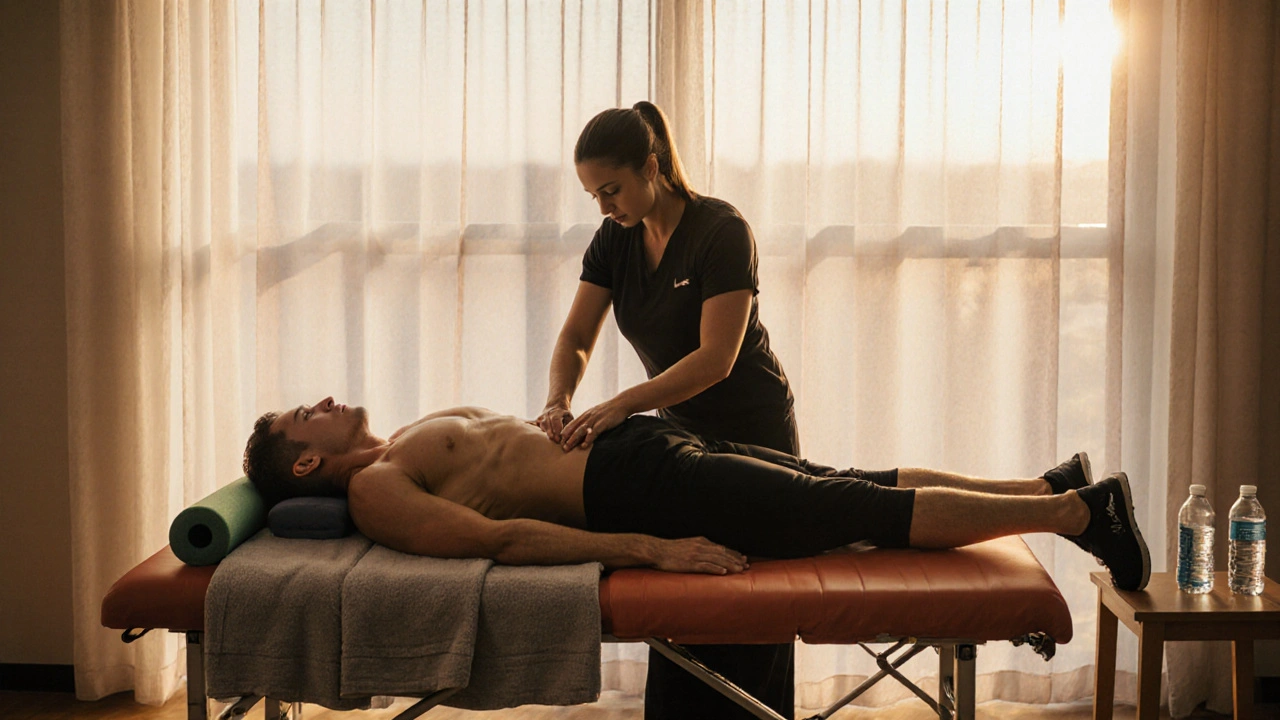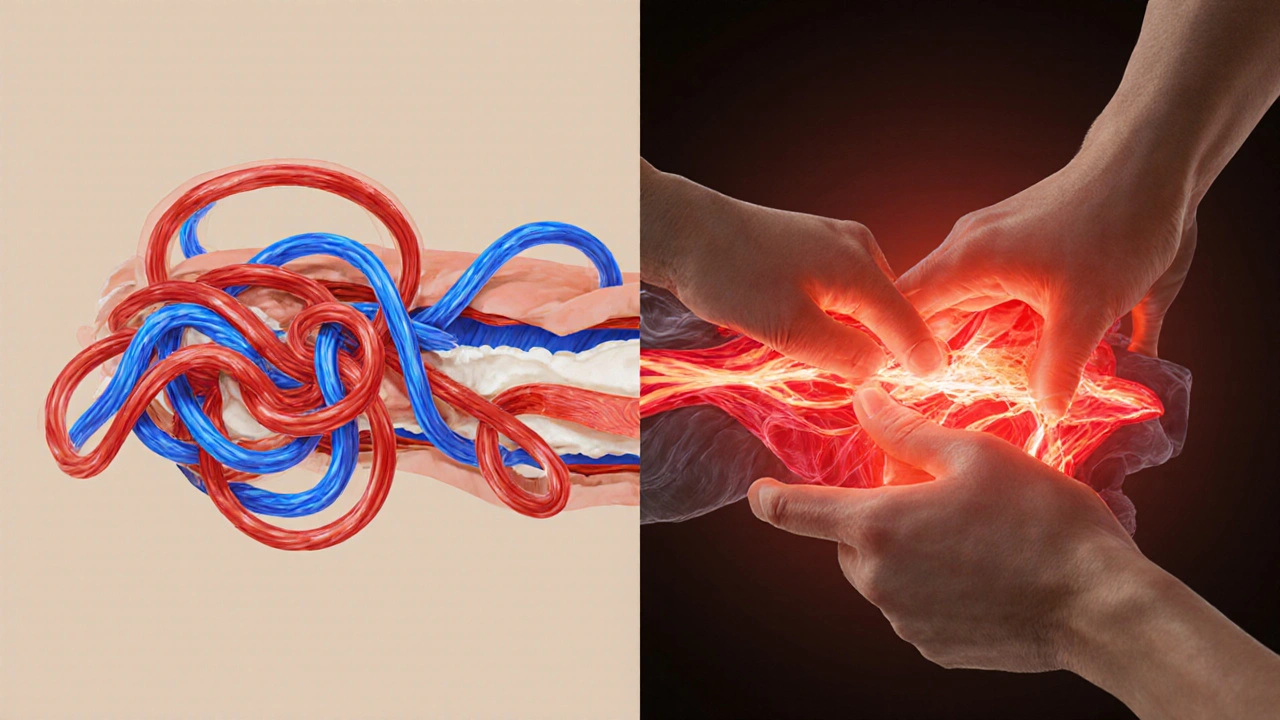Body Massage: Why It’s Essential for Your Fitness Routine

You’ve crushed your workout. Legs burning, shoulders tight, maybe even a dull ache in your lower back. You stretch, you foam roll, you ice down - but something’s still missing. What if the missing piece isn’t another set or another hour on the treadmill, but a 60-minute session on a massage table? Body massage isn’t just a luxury for spa days. It’s a non-negotiable part of any serious fitness routine.
What Body Massage Actually Does for Your Muscles
Think of your muscles like a sponge. During a tough workout, they soak up lactic acid, inflammation, and micro-tears. Foam rollers and stretching help, but they’re surface-level. A professional body massage goes deeper - literally. It uses targeted pressure to break up adhesions, improve blood flow, and flush out metabolic waste. A 2017 study in the Journal of Athletic Training found that massage after intense exercise reduced muscle soreness by up to 30% and improved range of motion within 24 hours. That’s not magic. That’s physiology.
It’s not just about feeling good. It’s about performance. Tight muscles don’t fire efficiently. They pull on joints, throw off your form, and increase injury risk. A massage loosens those restrictions so your body moves the way it’s supposed to - fluid, strong, balanced.
Why Body Massage Beats Stretching Alone
You stretch every day. You even do yoga. So why bother with massage? Because stretching works on the surface. Massage works on the root.
Imagine your muscle fibers are tangled headphones. Stretching pulls on the ends - it might untangle a bit. But massage is like gently separating each strand, one by one. It targets fascia, the connective tissue that wraps around every muscle. When fascia gets stiff from repetitive motion (like running, lifting, cycling), it creates tension that stretching can’t reach. Massage releases that tension. You don’t just feel looser - you move better.
Elite athletes know this. NBA players get daily massages. Olympic swimmers use it between heats. You don’t need to be a pro to benefit. If you’re training hard, your body needs recovery that goes beyond static holds and dynamic lunges.
The Real Benefits: More Than Just Relaxation
Let’s cut through the hype. Body massage isn’t just about candles and lavender oil (though those are nice). Here’s what it actually delivers for someone who lifts, runs, or trains regularly:
- Reduced muscle soreness - DOMS (delayed onset muscle soreness) drops noticeably after a post-workout session.
- Faster recovery - Blood flow increases by up to 45% during massage, delivering oxygen and nutrients faster to tired tissues.
- Better sleep - Deep tissue work triggers parasympathetic response. You fall asleep quicker and sleep deeper - critical for muscle repair.
- Injury prevention - Tight hamstrings? Stiff shoulders? These are red flags. Regular massage catches tightness before it turns into a strain or tear.
- Improved mobility - You’ll notice you can squat deeper, reach further, twist easier. That’s not just flexibility - it’s functional movement restored.
One client, a 38-year-old CrossFit athlete, stopped getting injured after just three monthly massages. She wasn’t changing her workouts. She was just recovering smarter.
Types of Body Massage That Work for Fitness
Not all massages are created equal. If you’re using it for recovery, you need the right kind:
- Deep Tissue Massage - Best for chronic tightness, old injuries, or athletes with heavy lifting routines. Targets deeper muscle layers and fascia.
- Swedish Massage - Great for active recovery days. Lighter pressure, promotes circulation without overstimulating sore muscles.
- Trigger Point Therapy - Focuses on knots (trigger points) that refer pain elsewhere. Perfect for runners with IT band issues or lifters with tight traps.
- Myofascial Release - Uses sustained pressure to release fascial restrictions. Excellent for people who feel stiff all over, not just in one spot.
Most people start with deep tissue or myofascial release. If you’re new to massage, try a 60-minute session that combines both. You’ll feel the difference immediately.

When to Get a Massage in Your Training Cycle
Timing matters. A massage right after a heavy leg day? Perfect. Right before a race? Maybe not.
Here’s a simple schedule:
- Post-workout (24-48 hours after) - Best for recovery. Helps flush out lactic acid and reduces inflammation.
- Rest day - Ideal for deeper work. No risk of aggravating sore muscles.
- Weekly maintenance - Once a week keeps muscles pliable. Even if you’re not sore, tightness builds up slowly.
- Avoid 24-48 hours before competition - Too much pressure can leave you feeling sluggish or overly sensitive.
Think of it like sleep. You don’t wait until you’re exhausted to rest. You schedule it so you stay at peak performance.
What to Expect During Your First Session
First-timers often worry about pain or awkwardness. Here’s what actually happens:
You’ll lie on a warm table, covered with a sheet. The therapist leaves the room while you get comfortable. They’ll ask about your training routine, areas of tightness, and any injuries. No judgment. Just facts.
The massage starts with lighter strokes to warm the tissue, then moves into deeper pressure. You’ll feel tension release - sometimes a pleasant ache, sometimes a sudden “oh, that’s where I’ve been holding it.” If something hurts too much, speak up. Good therapists adjust on the spot.
You won’t be flipped like a pancake. No cracking. No forced stretching. Just steady, intentional pressure that melts tension. Afterward, you’ll feel lighter. Like your body finally remembered how to relax.
How Much Does It Cost? And How Often Should You Do It?
Prices vary by city and therapist experience, but here’s the real breakdown:
| Session Length | Average Cost | Recommended Frequency | Best For |
|---|---|---|---|
| 60 minutes | $60-$90 | Once a week | Regular athletes, heavy lifters |
| 90 minutes | $90-$130 | Once every 2 weeks | Endurance athletes, chronic tightness |
| 30 minutes | $35-$50 | As needed | Quick recovery after intense sessions |
That’s less than a personal training session. And unlike a trainer, a massage therapist doesn’t push you harder - they help you recover so you can train harder.
Start with one 60-minute session per week for a month. Then adjust based on how you feel. Some people switch to biweekly after their body adapts. Others stick with weekly - and never look back.

Red Flags: When Massage Isn’t Safe
Massage is safe for most people. But not everyone.
Avoid it if you have:
- Recent fractures or acute injuries (wait at least 72 hours)
- Open wounds, burns, or infections on the skin
- Blood clots or deep vein thrombosis (DVT)
- Severe osteoporosis or uncontrolled high blood pressure
Always tell your therapist about any medical conditions. If you’re pregnant, diabetic, or on blood thinners - they need to know. A good therapist will adjust their technique or refer you to someone who can help.
And never, ever push through sharp pain. A massage should feel like a good ache - not a scream.
Body Massage vs. Foam Rolling: Which One Wins?
You’ve got a foam roller. You’ve got a lacrosse ball. You’re doing all the right things. So why add massage?
| Feature | Body Massage | Foam Rolling |
|---|---|---|
| Depth of Pressure | Can reach deep fascia and muscle layers | Surface-level, limited control |
| Personalization | Therapist adapts to your body in real time | One-size-fits-all, you’re doing it yourself |
| Neurological Effect | Calms nervous system, reduces overall tension | Stimulates nerves, can increase alertness |
| Time Required | 60-90 minutes, hands-on | 10-20 minutes, self-administered |
| Cost | $60-$130 per session | $20-$50 for one-time investment |
Foam rolling is great for daily maintenance. But it’s not a replacement. Think of massage as the expert tune-up. Foam rolling is your daily oil change. You need both.
Frequently Asked Questions
Can body massage help with muscle growth?
Not directly - you don’t build muscle by getting massaged. But it creates the conditions for growth. By reducing inflammation and improving blood flow, massage helps your muscles recover faster between workouts. That means you can train more often and with better form, which leads to more consistent progress over time.
Is it better to get a massage before or after a workout?
After. A pre-workout massage can make you too relaxed or even sore, which hurts performance. Post-workout is ideal because it helps flush out waste products and reduces soreness. If you want to loosen up before training, try dynamic stretching or a light warm-up instead.
Do I need to be sore to benefit from a massage?
No. In fact, the best time to get a massage is when you’re not sore - because that’s when you can catch tightness before it turns into pain. Regular massage keeps your muscles supple, which prevents injuries more than it treats them.
How long do the effects of a massage last?
The immediate relaxation lasts a few hours. The recovery benefits - reduced soreness, improved mobility - last 2-5 days. For lasting change, you need consistency. One massage won’t fix years of tension. But three a month? That’s a game-changer.
Can I do body massage at home with tools?
You can use tools like massage guns or foam rollers for daily maintenance, but they can’t replace a trained therapist. Human hands can feel subtle changes in tissue texture, adjust pressure in real time, and target areas you can’t reach yourself. Tools are supplements - not substitutes.
Ready to Train Smarter?
You don’t need to be an elite athlete to deserve recovery that works. Whether you’re lifting weights, running marathons, or just trying to keep up with your kids without back pain - your body is working hard. It deserves more than ice packs and static stretches.
Body massage isn’t a reward. It’s a requirement. For your muscles. For your joints. For your long-term fitness. Start with one session. See how you feel. Then do it again. In a month, you won’t just feel better - you’ll wonder how you ever trained without it.


